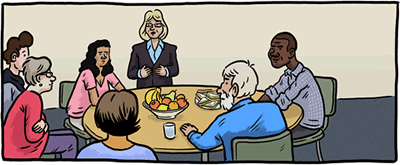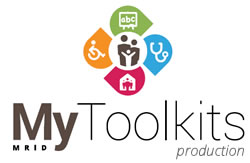On the day of a SchoolKit Transition Clinic the school, as hosts, welcomes and extends every courtesy to visitors, and the family and young person in particular.
This will involve ensuring that support staff are briefed so they can direct visitors to the right place as they arrive.
Putting the Family at Ease
Everything that happens during a SchoolKit Transition Clinic revolves around the young person and their family. Every effort should be made to make them welcome and to put them at ease, including:
- All participants should introduce themselves, explain their profession and name the agency they are representing (name tags may help). In particular, the transition care coordinator’s role and responsibilities will be explained to the family, and they can be introduced to adult clinicians who may have a significant role in their ongoing care.
- The purpose of the clinic should be explained verbally for the benefit of both the parents or carers and also the adult health and other service providers.
- Warm, friendly language and an open style of communication are important throughout. As is a good sense of humour.
- Questions are asked in a sensitive way and are open-ended wherever possible.
- Jargon, technical language, professional terminology and acronyms should be avoided wherever possible. If they are used, an explanation as to what is being discussed should be explained in clear, plain-English language.
- It must be remembered that the people being talked about are present in the room – use names and be respectful at all times.
- The group’s respect for the family’s privacy and the confidentiality of all information shared during the clinic should also be reiterated. It should be checked that the family also understands and agrees that some conversations will be held between the school, the health team, the transition care coordinator and other service providers outside of the clinic so as to facilitate whatever actions may be necessary to help meet their needs.

In a SchoolKit Transition Clinic, parents or carers are respected as the experts in understanding their daughter or son and directing their care. It is essential that this is emphasised in the way that all other clinic participants address, talk to, and respond to them. The value of their contribution should be stressed and their thoughts and ideas validated at every opportunity.
Getting Underway
Once everyone is seated, and food and drink has been offered, the nominated chairperson will lead introductions and open discussion.
The clinic will then progress, with all participants actively contributing, as follows:
- The family will be invited to share the particular issues they would like to be addressed during the clinic, as well as their hopes and expectations for their child’s future and what consideration they have given to what his or her post-school life might involve.
- The medical history will be reviewed, ensuring any gaps in service (e.g. immunisations not completed, dental reviews overdue) are identified and options to address these discussed.
- Depending on the needs of the young person, further details will be clarified regarding medical issues and ongoing management. This is an opportunity for the medical history to be handed over to the adult physician who will continue to care for the young person.
- A transition information kit will be provided to the family that may include information about post-school options, post-school educational support, CentreLink benefits and other allowances, GP services, managing parental stress and support, and self-management skills. These will also be discussed during the clinic.
- All participating professionals are encouraged to listen closely with an open mind.
- Throughout the clinic, advances in discussion and progress in putting plans in place to help smooth transition from child and adolescent services to adult services should be acknowledged and applauded.
Concluding With a Clear Plan
It is important that all participants come away from a SchoolKit Transition Clinic with a clear understanding of the agreed transition plan that will be put in place to meet the needs of the child and their family, the various different things that will be done by different people in the group, and what actions are required of them specifically.
Everyone in this partnership has a role to play in achieving the desired outcomes.







